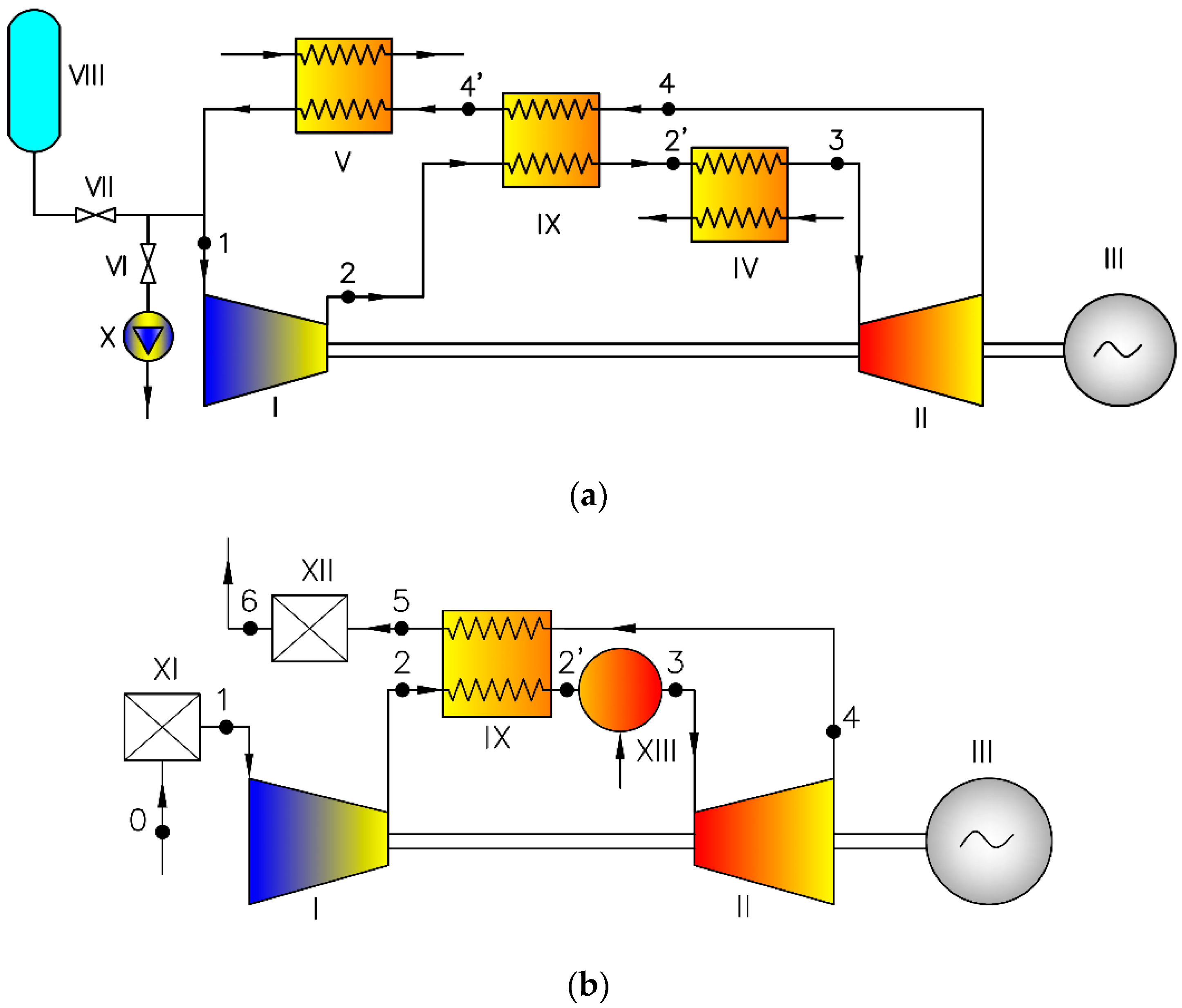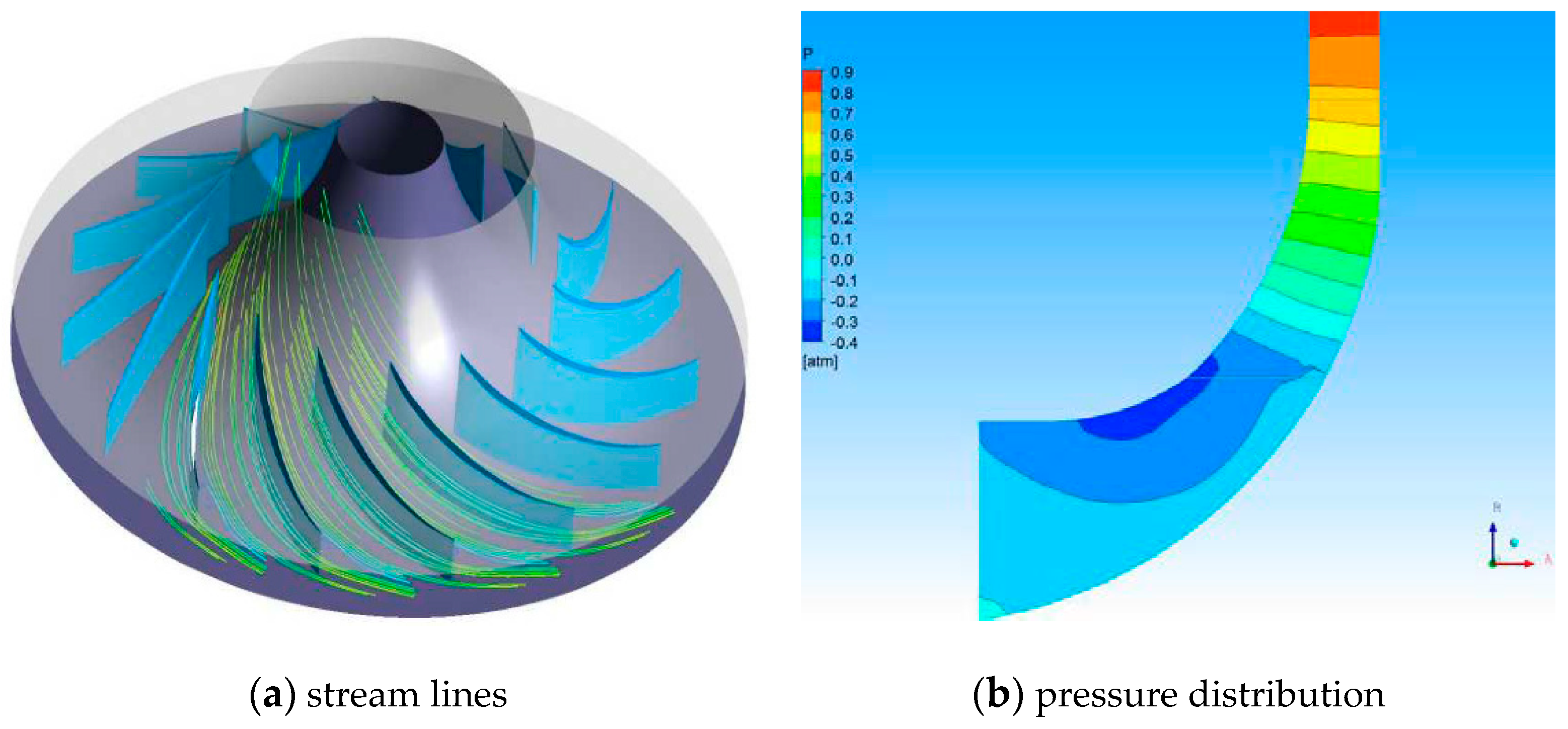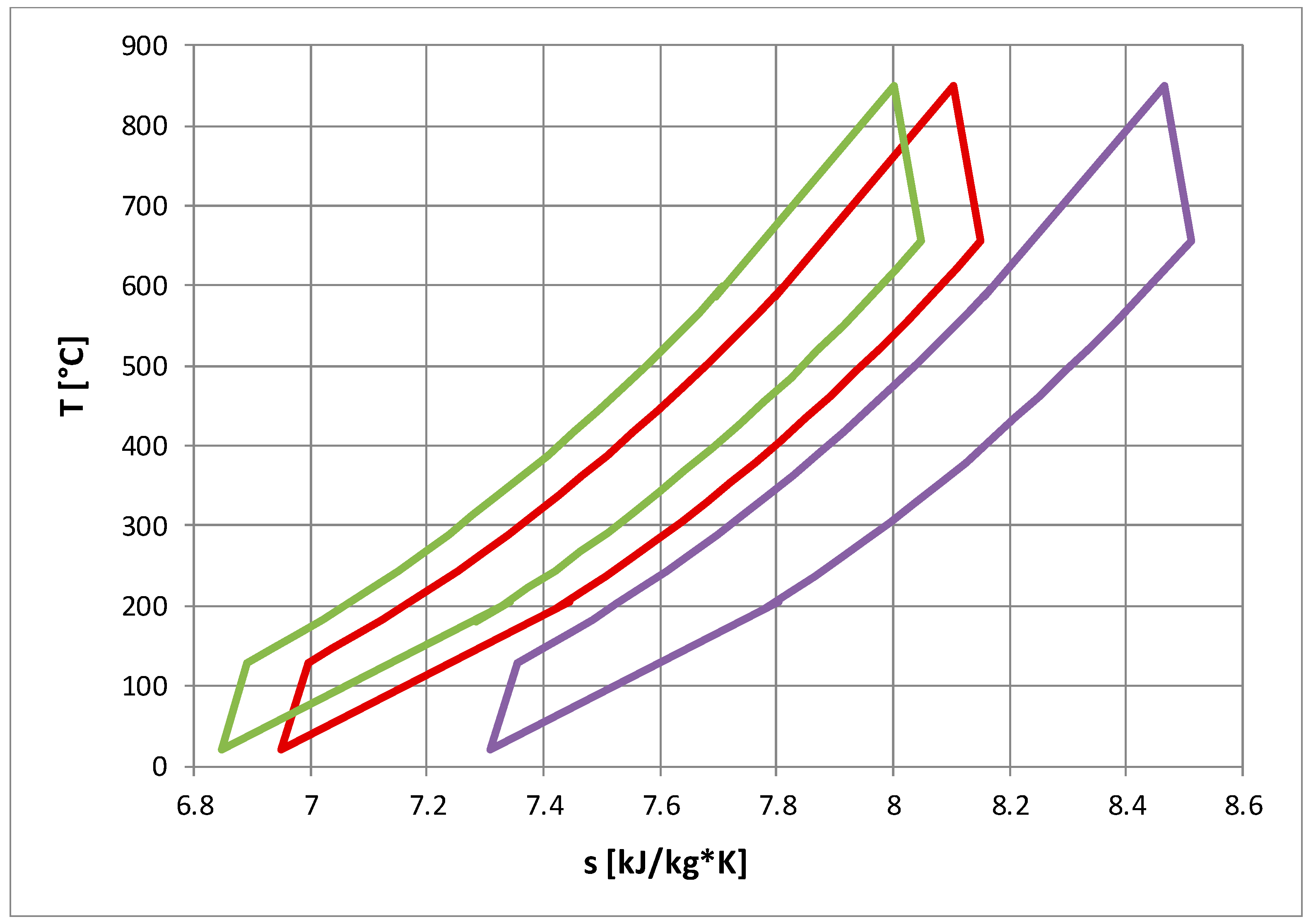Design Analysis of Micro Gas Turbines in Closed Cycles
Abstract
:1. Introduction
- -
- possibility of burning different kinds of fuel (due to an external combustion chamber),
- -
- possibility of using the high pressure of the medium (higher pressure means higher medium density, on the one hand leading to smaller dimensions for the same output, on the other hand enabling the building of high output units),
- -
- possibility of applying different gases as a working medium, in particular gases with better heat exchange parameters and a high value of specific heat cp, remarkably reducing dimensions and increasing specific turbine output.
2. Modelling
- -
- heat delivered to the working media (heater IV):
- -
- heat rejected with the water cooling the heater (V):
- -
- turbine work obtained by CFD calculations,
- -
- compressor work obtained by CFD calculations.
3. Results and Discussion
4. Conclusions
Author Contributions
Funding
Acknowledgments
Conflicts of Interest
References
- Kosowski, K.; Włodarski, W.; Piwowarski, M.; Stępień, R. Performance characteristics of a micro-turbine. Adv. Vib. Eng. 2014, 2, 341–350. [Google Scholar]
- Stępniak, D.; Piwowarski, M. Analyzing selection of low-temperature medium for cogeneration micro power plant. Pol. J. Environ. Stud. 2014, 23, 1417–1421. [Google Scholar]
- Thu, K.; Saha, B.B.; Chua, K.; Bui, T.D. Thermodynamic analysis on the part-load performance of a microturbine system for micro/mini-CHP applications. Appl. Energy 2016, 178, 600–608. [Google Scholar] [CrossRef]
- Kosowski, K.; Stępień, R.; Włodarski, W.; Piwowarski, M.; Hirt, Ł. Partial admission stages of high efficiency for a microturbine. J. Vib. Eng. Technol. 2014, 2, 441–448. [Google Scholar]
- Soares, C. Microturbines: Applications for Distributed Energy Systems, 1st ed.; Elsevier’s Science & Technology: Oxford, UK, 2007; ISBN 978-0750684699. [Google Scholar]
- Włodarski, W. Experimental investigations and simulations of the microturbine unit with permanent magnet generator. Energy 2018, 158, 59–71. [Google Scholar] [CrossRef]
- Włodarski, W. Control of a vapour microturbine set in cogeneration applications. ISA Trans. 2019, 94, 276–293. [Google Scholar] [CrossRef]
- Włodarski, W. A model development and experimental verification for a vapour microturbine with a permanent magnet synchronous generator. Appl. Energy 2019, 252, 113430. [Google Scholar] [CrossRef]
- Saadabadi, S.A.; Thattai, A.T.; Fan, L.; Lindeboom, R.E.; Spanjers, H.; Aravind, P. Solid Oxide Fuel Cells fuelled with biogas: Potential and constraints. Renew. Energy 2019, 134, 194–214. [Google Scholar] [CrossRef]
- Kwaśniewski, T.; Piwowarski, M. Design analysis of hybrid gas turbine‒fuel cell power plant in stationary and marine applications. Pol. Marit. Res. 2020, 2, 107–119. [Google Scholar] [CrossRef]
- Cozzolino, R.; Lombardi, L.; Tribioli, L. Use of biogas from biowaste in a solid oxide fuel cell stack: Application to an off-grid power plant. Renew. Energy 2017, 111, 781–791. [Google Scholar] [CrossRef]
- Herrando, M.; Pantaleo, A.M.; Wang, K.; Markides, C.N. Solar combined cooling, heating and power systems based on hybrid PVT, PV or solar-thermal collectors for building applications. Renew. Energy 2019, 143, 637–647. [Google Scholar] [CrossRef]
- Hsu, P.-C.; Huang, B.J.; Wu, P.-H.; Wu, W.-H.; Lee, M.-J.; Yeh, J.-F.; Wang, Y.-H.; Tsai, J.-H.; Li, K.; Lee, K.-Y. Long-term Energy Generation Efficiency of Solar PV System for Self-consumption. Energy Procedia 2017, 141, 91–95. [Google Scholar] [CrossRef]
- Kunniyoor, V.; Singh, P.; Nadella, K. Value of closed-cycle gas turbines with design assessment. Appl. Energy 2020, 269, 114950. [Google Scholar] [CrossRef]
- Bammert, K.; Rurik, J.; Griepentrog, H. Highlights and Future Development of Closed-Cycle Gas Turbines. J. Eng. Power 1974, 96, 342–348. [Google Scholar] [CrossRef]
- Kehlhofer, R.; Kunze, N.; Lehmann, J.; Schüller, K.H. Gasturbinenkraftwerke, Kombikraftwerke, Heizkraftwerke und Industriekraftwerke Resch, Handbuchreihe Energie; Band 7; Technischer Verlag Resch: München, Germany, 1992; ISBN 3-88585-094-X. [Google Scholar]
- McDonald, C.F.; Boland, C.R. The Nuclear Closed-Cycle Gas Turbine (HTGR-GT)—Dry Cooled Commercial Power Plant Studies. J. Eng. Power 1981, 103, 89–100. [Google Scholar] [CrossRef] [Green Version]
- Wolf, J.; Perkavec, M. Neuste Entwicklungen im Gasturbinenbau—Gasturbinen in Energetischen Anlagen; VDI Berichte: Leverkusen, Deutchland, 1998. [Google Scholar]
- Ahn, Y.; Lee, J.I. Study of various Brayton cycle designs for small modular sodium-cooled fast reactor. Nucl. Eng. Des. 2014, 276, 128–141. [Google Scholar] [CrossRef]
- Bae, S.J.; Lee, J.; Ahn, Y.; Lee, J.I. Preliminary studies of compact Brayton cycle performance for Small Modular High Temperature Gas-cooled Reactor system. Ann. Nucl. Energy 2015, 75, 11–19. [Google Scholar] [CrossRef]
- Malik, A.; Zheng, Q.; Qureshi, S.R.; Zaidi, A.A. Effect of helium xenon as working fluid on the compressor of power conversion unit of closed Brayton cycle HTGR power plant. Int. J. Hydrogen Energy 2020, 45, 10119–10129. [Google Scholar] [CrossRef]
- Stein, W.H.; Buck, R. Advanced power cycles for concentrated solar power. Sol. Energy 2017, 152, 91–105. [Google Scholar] [CrossRef] [Green Version]
- Kizilkan, O.; Khanmohammadi, S.; Saadat-Targhi, M. Solar based CO2 power cycle employing thermoelectric generator and absorption refrigeration: Thermodynamic assessment and multi-objective optimization. Energy Convers. Manag. 2019, 200, 112072. [Google Scholar] [CrossRef]
- McDonald, C.F. Helium turbomachinery operating experience from gas turbine power plants and test facilities. Appl. Therm. Eng. 2012, 44, 108–142. [Google Scholar] [CrossRef]
- Tournier, J.-M.P.; El-Genk, M.S. Properties of noble gases and binary mixtures for closed Brayton Cycle applications. Energy Convers. Manag. 2008, 49, 469–492. [Google Scholar] [CrossRef]
- Liese, E.; Albright, J.; Zitney, S.A. Startup, shutdown, and load-following simulations of a 10 MWe supercritical CO2 recompression closed Brayton cycle. Appl. Energy 2020, 277, 115628. [Google Scholar] [CrossRef]
- Ma, Y.; Liu, M.; Yan, J.; Liu, J. Performance investigation of a novel closed Brayton cycle using supercritical CO2-based mixture as working fluid integrated with a LiBr absorption chiller. Appl. Therm. Eng. 2018, 141, 531–547. [Google Scholar] [CrossRef]
- Olumayegun, O.; Wang, M.; Kelsall, G. Closed-cycle gas turbine for power generation: A state-of-the-art review. Fuel 2016, 180, 694–717. [Google Scholar] [CrossRef]
- Liu, H.; Chi, Z.; Zang, S. Optimization of a closed Brayton cycle for space power systems. Appl. Therm. Eng. 2020, 179, 115611. [Google Scholar] [CrossRef]
- Sadatsakkak, S.A.; Ahmadi, M.H.; Ahmadi, M.A. Thermodynamic and thermo-economic analysis and optimization of an irreversible regenerative closed Brayton cycle. Energy Convers. Manag. 2015, 94, 124–129. [Google Scholar] [CrossRef]
- Miao, H.; Wang, Z.; Niu, Y. Key issues and cooling performance comparison of different closed Brayton cycle based cooling systems for scramjet. Appl. Therm. Eng. 2020, 179, 115751. [Google Scholar] [CrossRef]
- Kosowski, K. Steam and Gas Turbines with the Examples of Alstom Technology; Alstom: Saint-Ouen, France, 2007; ISBN 978-83-925959-3-9. [Google Scholar]
- Mikielewicz, D.; Kosowski, K.; Tucki, K.; Piwowarski, M.; Stępień, R.; Orynycz, O.; Włodarski, W. Gas Turbine Cycle with External Combustion Chamber for Prosumer and Distributed Energy Systems. Energies 2019, 12, 3501. [Google Scholar] [CrossRef] [Green Version]
- Mikielewicz, D.; Kosowski, K.; Tucki, K.; Piwowarski, M.; Stępień, R.; Orynycz, O.; Włodarski, W. Influence of Different Biofuels on the Efficiency of Gas Turbine Cycles for Prosumer and Distributed Energy Power Plants. Energies 2019, 12, 3173. [Google Scholar] [CrossRef] [Green Version]
- Lemmon, E.; Huber, M.; McLinden, M. NIST Standard Reference Database 23: Reference Fluid Thermodynamic and Transport Properties-REFPROP. In Standard Reference Data Program; Version 9.0 edition; National Institute of Standards and Technology: Gaithersburg, MD, USA, 2010. [Google Scholar]













| Symbol | Description | Unit |
|---|---|---|
| D | diameter | [m] |
| i | enthalpy of unit mass | [kJ/kg] |
| l | blade height | [m] |
| m | mass flow rate | [kg/s] |
| Ma | Mach number | [-] |
| n | rotational speed | [rpm] |
| N | power | [kW] |
| p | pressure | [Pa] |
| Re | Reynolds number | [-] |
| Q | heat flux | [kW] |
| s | entropy of unit mass | [kJ/kg·K] |
| T | temperature | [°C] |
| V | volumetric flow rate | [m3/s] |
| η | efficiency | [-] |
| α1 | angle of absolute velocity vector at nozzle exit | [°] |
| α2 | angle of absolute velocity vector at blade exit | [°] |
| β1 | angle of relative velocity vector at nozzle exit | [°] |
| β2 | angle of relative velocity vector at blade exit | [°] |
| Δ | gradient | [-] |
| П | compressor pressure ratio | [-] |
| σ | regenerator efficiency | [-] |
| Symbol | Description |
|---|---|
| G | generator |
| K | compressor |
| el | electrical |
| m | mechanical |
| n | leakage |
| R | regenerator |
| T | turbine |
| D | delivered |
| 1, 2, … | numbers on diagrams |
| Description | Unit | Value |
|---|---|---|
| compressor efficiency | [-] | from CFD calculations of particular variant |
| turbine efficiency | [-] | from CFD calculations of particular variant |
| mechanical efficiency | [-] | 0.980 |
| leakage losses | [-] | 0.02 |
| generator efficiency | [-] | 0.900 |
| sum of pressure losses | [-] | 0.06 |
| Description | Unit | Value | ||
|---|---|---|---|---|
| Ne | [kW] | 50.0 | 35.0 | 10.0 |
| П | [-] | 2.6 | 2.4 | 2.2 |
| p1 | [MPa] | 0.1000 | 0.1000 | 0.1000 |
| T3 | [°C] | 850.00 | 850.00 | 850.00 |
| ηREG | [-] | 0.87 | 0.87 | 0.88 |
| mpow | [kg/s] | 0.5181 | 0.4722 | 0.1681 |
| ηel | [-] | 0.31259 | 0.26911 | 0.23665 |
| n | [rpm] | 55,000 | 65,000 | 120,000 |
| D1K | [m] | 0.0790 | 0.0673 | 0.0367 |
| D2K | [m] | 0.1437 | 0.1223 | 0.0667 |
| ηK | [-] | 0.83 | 0.78 | 0.75 |
| Maw2 | [-] | 0.29 | 0.33 | 0.32 |
| Mac2 | [-] | 0.74 | 0.73 | 0.73 |
| Rec3 | [-] | 326,161.41 | 327,239.87 | 335,282.76 |
| α1 | [°] | 90.00 | 90.00 | 90.00 |
| β1 | [°] | 30.00 | 30.00 | 30.00 |
| β2 | [°] | 44.01 | 45.12 | 41.53 |
| α2 | [°] | 15.51 | 15.98 | 12.92 |
| l1K | [m] | 0.0159 | 0.0139 | 0.0750 |
| l2K | [m] | 0.0085 | 0.0070 | 0.0043 |
| DT | [m] | 0.1477 | 0.1151 | 0.0688 |
| l1T | [m] | 0.0170 | 0.0164 | 0.0120 |
| l2T | [m] | 0.0180 | 0.1720 | 0.0124 |
| ηT | [-] | 0.83 | 0.79 | 0.76 |
| Mac1 | [-] | 0.71 | 0.73 | 0.74 |
| Maw2 | [-] | 0.74 | 0.79 | 0.79 |
| α1 | [°] | 17.50 | 17.00 | 11.00 |
| β1 | [°] | 83.32 | 70.79 | 85.11 |
| β2 | [°] | 21.78 | 21.26 | 14.73 |
| α2 | [°] | 87.04 | 73.96 | 89.93 |
Publisher’s Note: MDPI stays neutral with regard to jurisdictional claims in published maps and institutional affiliations. |
© 2020 by the authors. Licensee MDPI, Basel, Switzerland. This article is an open access article distributed under the terms and conditions of the Creative Commons Attribution (CC BY) license (http://creativecommons.org/licenses/by/4.0/).
Share and Cite
Kosowski, K.; Piwowarski, M. Design Analysis of Micro Gas Turbines in Closed Cycles. Energies 2020, 13, 5790. https://doi.org/10.3390/en13215790
Kosowski K, Piwowarski M. Design Analysis of Micro Gas Turbines in Closed Cycles. Energies. 2020; 13(21):5790. https://doi.org/10.3390/en13215790
Chicago/Turabian StyleKosowski, Krzysztof, and Marian Piwowarski. 2020. "Design Analysis of Micro Gas Turbines in Closed Cycles" Energies 13, no. 21: 5790. https://doi.org/10.3390/en13215790





